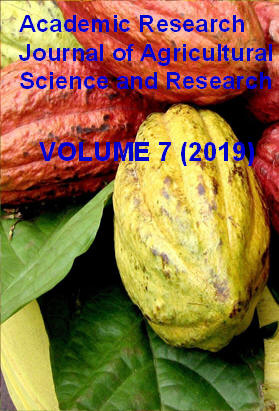|
ISSN: 2360-7874 |
Academic Research Journal of
Agricultural Science and Research |
|||||||||||||||||||
|
Vol. 7(4), pp. 176-189, May 2019 Full Length Research Heterosis and combining ability for grain and biomass yield in sorghum hybrids for the semi-arid lowlands of Eastern Kenya
Patrick Sheunda 1,2, Felister M Nzuve1, Eric O Manyasa2, George N Chemining’wa1
1Department of Plant Science and Crop Protection, University of Nairobi, P.O. BOX29053- 00625 Nairobi Kenya 2 International Crops Research Institute for the Semi-Arid Tropics (ICRISAT), P.O BOX 39063-00623, Nairobi Kenya Correspondence regarding this paper should be addressed to Patrick Sheunda, ICRISAT-Nairobi, P.O. Box 39063-00623 Nairobi, Kenya; email: p.sheunda@cgiar.org
Accepted 15 May 2019
Sorghum [Sorghum bicolor (L.) Moench] is an important cereal crop used for food, feed, and industrial raw material. In Kenya, it’s a food and nutritional security crop in the semi-arid areas which are prone to maize crop failures. The study aimed at estimating the combining ability and heterosis for grain and biomass yield among sorghum hybrids. Thirty- four F1 sorghum hybrids, their parents and a check were evaluated at two KALRO research centers in Kenya during the 2014-2015 cropping seasons. Square lattice trial design with three replications was used and fourteen agro-morphological traits studied at each location. The combined analysis of variance showed highly significant differences (p<0.001) for genotypes and locations for all traits, except for leaf length. Fresh biomass yield, panicle exertion, and plant height had high heritability, genotypic coefficient of variation (GCV) and genetic advance (GA %) showing the predominance of additive gene effect in their inheritance, hence these traits can be improved through direct phenotypic selection. Hybrid parents ICSR 89058, ICSV 700 and ICSR 160 were good general combiners for earliness, biomass and grain yield respectively. The highest grain and biomass yielders were ATX 623 x Macia and ICSA 206 x IESV 91104DL respectively. High magnitudes of SCA effect coupled with high heterobeltiosis, mean and standard heterosis for grain and biomass yield were noted in hybrids ATX 623 x Macia and ICSA 11035 x Macia respectively. These hybrids can be promoted for on-farm testing and possible release for food and fodder. Therefore, the improvement of sorghum grain and forage yields in the semi-arid areas of Kenya can be done simultaneously through the exploitation of heterosis by developing hybrids.
Key words: Combining ability, heritability, heterobeltiosis, heterosis, additive gene effect, restorers.
How to cite this article (APA Style): Sheunda P., Nzuve FM., Manyasa EO., Chemining’wa GN (2019). Heterosis and combining ability for grain and biomass yield in sorghum hybrids for the semi-arid lowlands of Eastern Kenya. Acad. Res. J. Agri. Sci. Res. 7(4): 176-189
|
|||||||||||||||||||
